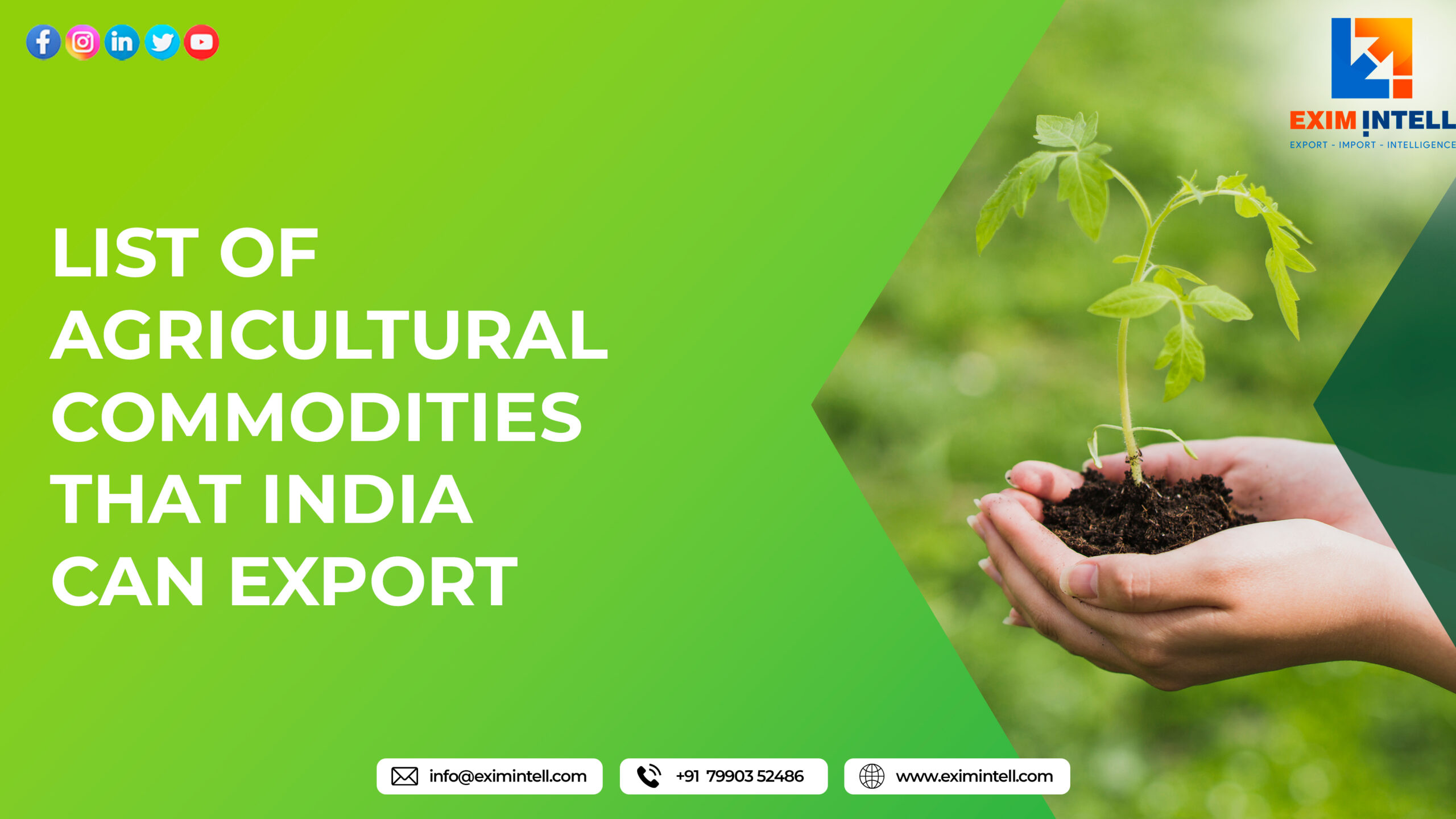Despite the fact that India’s overall goods exports fell by 7.2% to $ 290.8 billion in 2020-21 from $313.4 billion in 2019-20, India’s Agriculture Products Export nonetheless increased by 17.5 percent, crossing the $41.8 billion threshold.
On the front of agricultural exports, India has been doing quite well recently. Several organizations, including the Agriculture and Process Food Products Export Development Authority (APEDA) and the Marine Products Export Development Authority (MPEDA), as well as commodity boards, including the Coffee Board, Ruber Board, and Spices Board, among others, have been given the authority to promote the export of a variety of agriculturally relating commodities. In this essay, we will go through the top 10 agricultural products that India exports across the world.
Knowing the Agricultural Products of India
It is possible to classify India’s Agriculture Products Export into one of three primary groups: a) export of raw goods; b) export of semi-raw products; and c) export of processed as well as ready-to-eat items. Raw items often have a low value but a large volume of exports, whereas semi-processed products have an intermediate value but a restricted volume and processed ready-to-eat products have a high value but a low volume of exports.

India’s primary Agriculture Products Export include grains (mainly rice, both Basmati and non-Basmati varieties), spices, cashews, oilcake/meals, tobacco, tea, and coffee, as well as marine goods. The percentage of the value of a country’s overall exports that comes from agricultural products typically falls between 15 and 20 percent. Even while there has been an uptick in the export of marine goods, this benefit has been more than negate by the dramatic decrease in the export prices of soya meal. Which as of late has been one of the most important export items.
Non-Basmati Rice
The term “Non-Basmati Rice” refers to any kind of rice that is not Basmati Rice. There are over one thousand different types of rice in existence around the globe, the majority of which may be found in India. In the fiscal year 2020-21, India sent over 130 lakh MT worth of rice that was not of the Basmati kind. The money that was earn by its export was around 35,000 crores of rupees.
Basmati Rice:
Exports account for close to two thirds of India’s total Basmati rice production. Rice of the finest as well as most sought-after quality in the world commands a high price on the international market. Karnal local, Basmati 370, Basmati 385, as well as other types of Basmati rice are among the many exportable variants of this kind of rice. The previous year saw the export of 46 lakh MT of basmati Rice, which resulted in a revenue of Rs. 29,000 crores being earn from the export of this product.
Various processing Items:
Among them are dry soups, concentrates of soft drinks and other beverages, ice cream, sauces, pan masala, mineral water, custard powder, as well as other similar products. It resulted in a return of 6.389 trillion rupees.
Fruits:
The entire income that was made from the export of fresh fruit in the previous year was Rs 5,641 crores. The following types of fruit have a significant potential for export:
- Mangoes Varieties- Langra, Chausa, Fazli, Krishna Bhog, Neelam
- Grapes Varieties- Anab-e-shahi, Cheema sahebi, kishmishchorni
- Golden Delicious, Lal Ambri, and ChaubattiaAnupam are the three apple varieties.
- Dwarf Cavendish, Robusta, and Rasthali are the three fresh banana varieties available.
- Guava Varieties- L-49, Allahabad Safeda, Banarasi, Chittidar
Groundnut:
The previous fiscal year saw the export of a total of 6 lakh MT of groundnuts. The total value of which is 5381 billion rupees. Groundnut cultivars with a high potential for export include Kadiri-2 and Kadiri-3, as well as BG-1 and BG-2, Kuber, T-28 and T-64, Chandra and Chitra, and others.
Fresh Vegetables:
The most amount of vegetables are sent out of India than any other country. The export of vegetables in the fiscal year 2020-21 was 23 lakh MT, which was equivalent to over Rs 5371 crores. The following types of vegetables have the potential to be exported:
Onion
- Potato Varieties – Kufri Chandramukhi, Kufri Badshah, Kufri Bahar
- Tomato Varieties – Vaishali, Rupali, Rashmi, Rajni, Pusa Ruby
- Some of the varieties of cauliflower are called Pusa Deepali, Early Kunwari, and Punjab Giant-26.
- Golden Acre, Pusa Mukta, and Pusa Drumhead are some of the varieties of cabbage.
- Peas Varieties- Asauji, Lucknow Boniya, Alaska
- Okra Varieties- Pusa makhmali, Punjab Padmini, Pusa sawani, Parbhani Kranti
- Walnut
Processed Fruits and Vegetables
India is one of the world’s leading manufacturers of dried and preserve vegetables, including preserve onions, preserve cucumbers, as well as preserved mushrooms, among others. Apple juice, fried chips, jams as well as jellies, pineapple juice, olives, and other process fruits and vegetables all have the potential to export. Some examples include these. So, the value of processed fruits and vegetables is Rs. 5149 crores for a quantity of 5 lakh MT.
Other types of cereals:
India is responsible for the production of the greatest quantity of grains worldwide. And the enormous demand for cereals on international markets provides an ideal setting for the export of Indian cereals. The most vital grains are wheat, paddy, sorghum, millet, barley, as well as others like them. A total of Rs 5116 crores was brought in thanks to the export of cereals.
Cereal preparations:
Some examples of Agriculture Products Export are the grain goods with significant potential for export are wheat or meslin flour, rye flour, maize flour, and wheat meal, amongst others. During the fiscal year 2020-21, a total of 4 lakh MT of grain preparations were sent overseas. This results in a return of Rs 2382 crores.


















